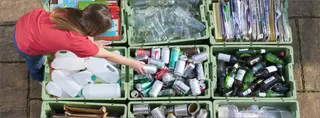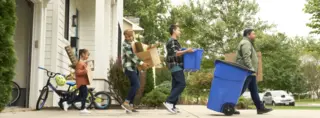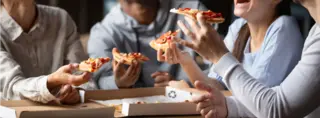
It’s easy to get confused about what can and can’t be recycled.
The No. 1 rule is to follow your local guidelines. Print them and post them by your recycling bins for quick reference.
But understanding why certain things can be recycled, and why others can’t, can help you remember the rules and explain them to others.
Common sense isn’t always the best guide. There’s a difference between an item being recyclable and an item being accepted by local recycling centers. Something that’s designed to be recycled might be accepted in one town but not the town down the road. This is the case with pizza boxes—designed to be recycled, but not always accepted.

Other items might be recyclable, but only in large quantities. Take plastic bags: You can’t recycle them curbside, but some retailers collect them to recycle in bulk. And as technology improves, recycling centers adapt to accept more items—good for the environment, but bad for confusion.
Here are some basic principles to help you better understand why paper can be recycled … and why some other common items can’t.
Why Is Paper Recyclable … But Not Napkins and Paper Towels?
One reason paper napkins aren’t recyclable is that the paper they’re made from is at the end of its recyclability. Paper can be recycled up to seven times, which is part of why it’s so sustainable. Every time it’s recycled, its fibers get shorter. So, while materials such as napkins and paper towels are often made from recycled materials, this is the last stop in their life cycle.
Why Is Paper Recyclable … But Not Always Paper Coffee Cups?

Actually, paper cups are starting to be accepted for recycling in more communities. Innovators are continuing to develop technology that can handle more complicated materials. In fact, a leading manufacturer has created a process with a recapture rate of up to 90%. Check your local recycling center’s guidelines to see whether it accepts coated paper.
As for why some programs won’t accept coated paper cups: Paper alone is recyclable, but things get tricky when it’s coated with a nonpaper substance. That’s because the equipment that recycles plain paper at your local center might not yet be able to process paper that’s been coated with another material.
Some other types of coated paper shouldn’t be recycled because their coatings could contaminate the recycling stream. For example, receipts printed with ink, like what you might get at a mom-and-pop shop, can be recycled. But receipts printed on slick thermal paper, like the kind you get at most self-checkouts, are coated with a chemical that enables ink-free printing. This means they should go in the trash, not the recycling.
Why Is Paper Recyclable … But Not Styrofoam?
Paper takeout containers are recyclable once they’re emptied and flattened because they’re made from a natural material. Polystyrene foam (Styrofoam) food containers are more complicated. They’re made from recyclable plastic, but because they are so lightweight, they take up a lot of volume for the amount of recyclable material they produce. Transporting polystyrene foam can be so expensive that it’s impractical on a large scale.
This is changing, as some recycling programs are bringing in foam densifiers to eliminate the transportation problem or finding other solutions. But polystyrene is banned in some places, leading it to be phased out in general. In most communities, it goes into the trash container.
Why Are Plastic Takeout Containers Usually Recyclable Curbside … But Plastic Bags Require Specific Locations?
Clear round plastic containers, molded plastic trays and plastic clamshells can generally be recycled. But “generally” doesn’t mean “always”: Some programs are unable to accept black plastic containers, for example. Check your local guidelines.
As for plastic bags and similar plastics such as food wrap, these tend to get tangled up in most recycling machinery, gumming up the works. They can be recycled, but only if you take them to a plastic film collection site, usually a grocery store or another retailer. Your local recycling website may guide you to the nearest collection site, or you can go here.
Why Is Glass Recyclable … But Not Mirrors?
Glass containers for food and beverages are widely accepted in recycling programs because they’re made from a specific type of glass. Mirror glass, along with other highly break-resistant glass from items such as windows and kitchenware, is made using a different process. Throwing a broken mirror into the recycling won’t just bring you seven years of bad luck—it could mess up the glass recycling process.

Why Is Metal Recyclable … But Not Foil Snack Bags?
Much like coated paper, foil snack bags (like the kind chips come in) are actually a mixture of two materials, metal and plastic. These require different types of recycling treatment that recycling centers aren’t yet equipped to handle—so into the trash they go.





